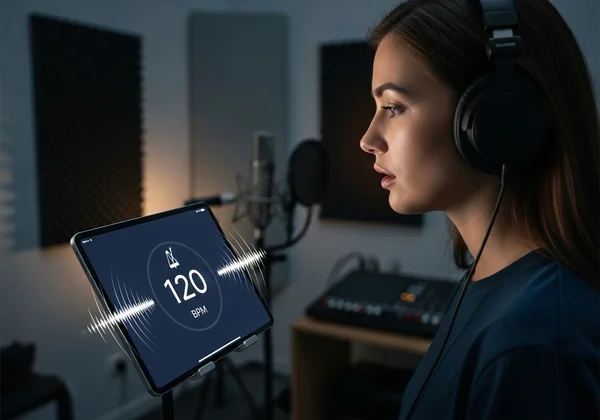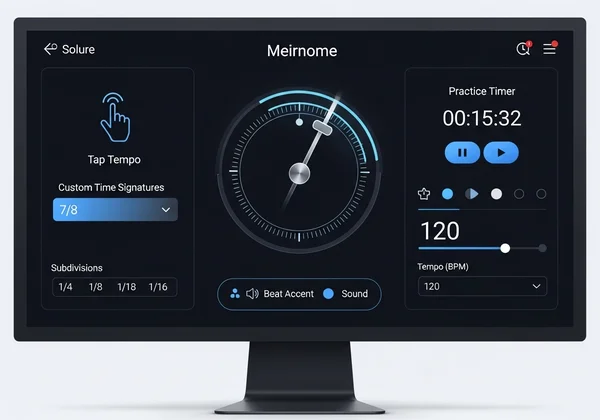Online Metronome for Singers: Boost Pitch & Vocal Rhythm
As a singer, you pour your heart into every note, striving for that perfect blend of emotion and technical skill. But what if one of the most powerful tools for vocal improvement isn't a complex breathing exercise or a fancy microphone, but a simple, steady click? Many vocalists overlook the online metronome, viewing it as a tool for drummers or pianists. The truth is, it's a singer's secret weapon. How can a metronome improve my singing? It builds the unshakable foundation of rhythm, pitch, and control that separates good singers from great ones.
This guide will show you how to transform your vocal skills using a free, accessible rhythm practice tool. We'll explore practical exercises for everything from nailing complex rhythms to perfecting your intonation. It's time to unlock your full vocal potential. You can begin right now by opening the free metronome tool and following along.

Mastering Vocal Rhythm & Phrasing with a Metronome
At its core, music is rhythm. A flawless vocal tone can be lost if the timing is off. Consistent practice with a metronome builds an internal clock, allowing you to deliver lyrics with confidence and precision, whether you're singing ahead of the beat for excitement or laying back for a soulful feel. This rhythmic mastery is a hallmark of professional vocalists.
Why Rhythmic Precision Matters for Singers
Have you ever heard a singer who sounds technically proficient but their performance feels... off? Often, the culprit is inconsistent timing. Rhythmic precision ensures you lock in perfectly with the band or backing track, creating a cohesive and powerful sound. It allows you to make conscious choices about phrasing—how you shape a line of lyrics—turning a simple melody into a compelling story. Without a strong rhythmic foundation, your phrasing can sound accidental and your performance ungrounded.
Basic Metronome Setup for Vocal Warm-ups
Integrating a metronome into your routine is easy. Before you even start singing scales, use it to warm up your sense of time. This simple step gets your brain ready for rhythm, making your whole practice session even more effective.
- Go to the online metronome tool: The tool is ready to use instantly, with no downloads required.
- Set a Slow Tempo: Start with a comfortable speed, like 60 BPM (beats per minute).
- Choose 4/4 Time: This is the most common time signature, with four beats per measure.
- Start the Click: Close your eyes and just clap along to the beat. Feel the pulse. Once you're locked in, start doing gentle vocal warm-ups, like lip trills or humming, ensuring each sound aligns perfectly with a click. Try it now and set a slow tempo to begin.
Exercises for Consistent Phrasing & Tempo Control
Once you're comfortable, you can move on to more specific exercises. Start by singing a simple five-note scale (do-re-mi-fa-so) up and down. At first, sing one note for every click. As you gain confidence, try singing one note every two clicks (half notes) or every four clicks (whole notes). This exercise trains you to maintain your tempo control and feel the space between the beats, which is essential for effective phrasing and breath management.
Sharpening Pitch & Intonation Using Your Metronome

While a metronome directly measures time, its indirect benefit on pitch is immense. Singers often go flat or sharp when they are rhythmically insecure, rushing through difficult passages or dragging behind on long notes. By providing a stable rhythmic anchor, a metronome frees up your mental energy to focus purely on hitting the center of each note. This is a key component of dedicated singing practice.
Syncing Pitch with the Beat for Accuracy
Many pitch problems are actually timing problems in disguise. When a singer anticipates a high note, they often rush towards it, causing their pitch to sharpen. Conversely, fatigue can cause a singer to fall slightly behind the beat, resulting in flat notes. Practicing with a metronome forces you to land each note at the precise moment it's meant to be heard, dramatically improving your overall pitch accuracy. Think of the click as the "landing strip" for each note you sing.
Interval Training with a Rhythmic Foundation
To take it a step further, use the metronome for interval training. Set a moderate tempo, perhaps 80 BPM. Sing the root note of a scale on beat one, then the third on beat one of the next measure, the fifth on the next, and so on. The steady click ensures you aren't just hitting the interval, but hitting it at the right time. This focused practice really builds your musicality and strengthens your ear-to-voice connection, making you a more reliable and confident performer.
Enhancing Breath Control & Sustained Notes

Breath control is the engine of the voice. A metronome is an invaluable tool for making your breathing more efficient and controlled. By timing your inhales and exhales against a steady beat, you can build the stamina needed to sustain long notes and deliver powerful phrases without gasping for air.
Using Metronome Subdivisions for Breath Pacing
Our online metronome resource allows you to add subdivisions—clicks between the main beats. Set the metronome to a slow tempo and turn on eighth-note subdivisions. Inhale slowly over four main clicks, then exhale on a steady "sss" sound for the next four clicks. The subdivisions help you maintain a perfectly smooth and controlled release of air. This exercise builds incredible support for sustained notes.
Building Stamina with Longer Phrases
Challenge your lung capacity by practicing holding a single note over multiple measures. Start by holding a comfortable pitch for two full measures of 4/4 time (eight clicks). As you get stronger, extend it to four measures (16 clicks), and then even longer. The goal is to keep the tone and volume perfectly consistent from the first click to the last. This builds the muscular endurance required for demanding vocal repertoire.
Unlocking Advanced Metronome Features for Vocalists

A simple click is powerful, but a feature-rich tool can supercharge your progress. Our free metronome was designed with the needs of serious musicians in mind, offering customization that can adapt to any vocal exercise you can imagine.
Tap Tempo: Finding Your Song's Natural Pace
Struggling to find the right tempo for a new song you're learning? Don't guess. Use the Tap Tempo feature. Simply listen to the recording and tap the button along with the beat. The metronome will instantly calculate the BPM for you, allowing you to start practicing at the correct speed immediately. This simple feature is a huge time-saver and a key to accurate practice.
Custom Time Signatures for Complex Vocal Pieces
Is your repertoire more complex than standard 4/4? Whether you're singing a waltz in 3/4, a progressive rock anthem in 7/8, or a classical art song with changing meters, our tool has you covered. You can easily set custom time signatures from 1 to 12 beats per measure, with options to add accents on specific beats. This flexibility ensures you can accurately practice any piece of music. Select your time signature and tackle that tricky piece.
The Practice Timer: Track Your Vocal Improvement
Consistency is the most important factor in improving any skill. The built-in practice timer helps you stay disciplined. Set a goal for your session—whether it's 15 minutes of warm-ups or a full hour of repertoire work—and let the timer keep you on track. Logging your practice time is a powerful motivator and helps you build a consistent, effective routine.
Elevate Your Voice: Consistent Practice, Confident Performance
The journey to becoming a better singer is built on consistent, focused practice. An online metronome is not a crutch; it's a coach that builds your internal sense of time, sharpens your pitch, and disciplines your breathing. By integrating this free, powerful online metronome tool into your daily routine, you are laying the groundwork for massive improvements in your vocal ability.
From basic warm-ups to complex phrasing, the steady click will be your most honest and reliable partner. Stop guessing and start training with precision. Your future audiences will thank you. Ready to transform your voice? Start practicing now.
Common Questions About Metronomes for Singers
What is a good tempo for vocal practice?
For beginners, a slow to moderate tempo, between 60 and 90 BPM, is ideal. This gives you enough time to think about your pitch, breath, and phrasing without feeling rushed. As you tackle faster songs, you can gradually increase the speed on a BPM counter to build speed and accuracy together.
How can a metronome improve my singing?
A metronome provides immediate, objective feedback on your timing. This helps you develop a rock-solid internal rhythm, which in turn improves your phrasing, pitch accuracy (by eliminating rushing/dragging), and breath control. It makes your singing more professional, confident, and musically intentional.
Is an online metronome good enough for serious vocalists?
Absolutely. Modern online tools like ours use advanced algorithms to ensure the timing is perfectly accurate and reliable. With features like tap tempo, custom time signatures, subdivisions, and a practice timer, the free metronome offers professional-grade functionality without the cost or inconvenience of a physical device. It's an essential tool for both serious musicians and casual learners.
How do I choose the right metronome sound for singing practice?
This is a matter of personal preference. Some singers prefer a sharp, cutting sound like a "Click" or "Woodblock" that slices through their own voice. Others may prefer a softer tone like a "Beep" or "Shaker" that feels less intrusive. Experiment with the different sound options on our metronome to find the one that helps you focus best without causing ear fatigue.